ESPECIALLY FOR WOMEN
There are certain techniques, which have been described in Appendix E, to which women fighters, and any other fighter having power problems, should pay particular attention. These are also techniques that can sometimes be modified slightly to provide more power. Others are often performed incorrectly. In some cases, I will mention a specific aspect of a technique that is of particular importance.
Problems 1, 2, 3, 8, and 10 described in Appendix E are the ones that are most likely to reduce the power of blows. Problem 11 is a problem that leads into many of these.
Problem 1 (feet in line) is the main issue for most women. If this one isn't fixed, nothing else matters. Unless the stance is corrected, the corrections of the other problems will not be sufficient to improve power enough to strike a "killing" blow.
The correction mentioned in Appendix E works because moving the back foot towards the sword side allows free movement of the hips. The correction also relies on keeping the sword foot back, to provide more power by driving forward during the swing.
The practice of fighting with the sword foot forward is an improvement over the modern fencing stance, in that it does allow hip movement. However, it is an over-correction. The problem with this practice is that it essentially starts the swing half way through, thereby losing the drive of the back leg, and much of the power that would be generated by the full rotation of the hips. I do not recommend this.
Problems 3 (using too much arm) and 8 (pushing back while swinging) are common to all fighters, but if you have power problems, these will make them very much worse. If you have either problem, especially number 8, and manage to correct it, you will notice an increase in power. Performed properly, the technique of moving your shield knee slightly forward adds the falling weight of your body to the twisting power of the hips to provide increased power for the sword. Again, technique practice and slow work are the keys. You are never going to be big-and-strong-and-fast. Being very good is a fine substitute.
Problem 4 (stepping with swings) is a real temptation for smaller fighters who have the problem of closing the distance to their opponent. It does get you in close, but it takes power away from the blow being thrown, and, since it is usually hurried, it tends to move the smaller fighter in too close. The proper range for most fighters is the one at which their sword easily reaches their opponent. If you get in much closer, the larger, stronger fighter can "power in" short blows, or use wraps, while you will be in too close to use your techniques properly.
The method by which I close distance is to have my sword be the first thing over the "maximum range" line. I use a technique that looks like a swing towards my opponent's head, but is in reality a moving block, with the sword tip fairly high, moving towards their sword. As it moves past my head, I allow my back foot to be pulled forward into a step. Note that I said that the sword should move past my head before the back foot is pulled forward. If you don't do this, then your head will likely be the part of you that crosses the line first. I refer to this latter, unfortunate practice as the "Rocky Balboa" style (leading with your head).
This whole method is actually a moving, nearly vertical sword block, not a "killing" swing. As the sword pulls the back foot into a step, power is taken away from the swing, and it will feel strange. This is acceptable; since the object is to close the range, not swing a killing blow. After the step, I will replace my sword, which should have impacted on my opponent's sword, or on the sword-edge corner of their shield, with my shield. At the same time, I move my shield foot up, and adjust my stance and distance.
Problem 9 (pulling returns into body) leads to loss of power and coordination, and makes combinations all but impossible.
This is a real killer, both literally and figuratively. If you don't make a conscientious effort to fix this, you will lose a lot of fights with your sword trapped close to your body, while your opponent pounds on you. The sword has to swing away from you, to give it freedom to move, and to allow it to gather kinetic energy. On the foreswing, it comes back in close for acceleration and guidance, but not on the backswing.
As an exercise, hold your sword from the wrong end with both hands. Swing it around in combinations. Alternatively, do pell work with both hands using a two-handed maul. Pay attention to the fact that you lean away from the weapon as you swing it. Pay attention to how it feels. This is the same way it works with single-handed swords.
Problem 10 (abdomen not tensed properly) seems to be endemic, but not exclusive, to women fighters. One of my more accomplished students, a male knight, had to be trained out of this one. It's difficult to work with this, because the wrong way is the easy way. The best results require that you practice in such a manner that you can pay attention to the problem. This means slow practice. You should have time both to notice and correct the problem during your exercises. It also means repetition. It's not as exciting as bashing, but it gets results.
Problem 11 (poor distance control) is one that can be avoided with a bit of practice. Unfortunately, many women are encouraged to be very aggressive, to close the range quickly and get inside. I'm not sure why this happens, but it is not good advice. The aggression is fine. It serves no purpose to tiptoe around out of range when you are fighting a better, faster fighter. Your opponent will be able to close with you very quickly, and at a time that is of their choosing. It is better to take the initiative, and get to your desired range as quickly as possible.
However, neither does it help to get inside quickly, if you end up too close. I have seen to many small fighters charge quickly into very short range, where they cannot properly swing their sword, cannot move their shield because it is jammed up against their opponents, cannot do a proper return because the pressure on their shield causes them to lean back (or too far forward), and leaves them completely open for wraps, if their opponent has a height or power advantage.
I urge you to read the discussion in problem four.
The other problems listed in Appendix E also deserve the attention of women fighters. All of them can cause trouble by reducing power and mobility.
Sword Weight & Balance
Often, women are recommended to use swords that are, essentially, short, heavy clubs. The reasons given usually are something like:
- Short swords should be used because they are easier to handle.
Unfortunately, although short swords are easier to handle, they also do not hit with power unless you have big, strong arms, and swing very hard. This choice is usually impractical for women.
- Heavy swords should be used to supply hitting power.
Heavy swords hit with more power, assuming that the fighter can swing them with enough speed and accuracy to get past shields. This is harder to do with a heavy sword, if you do not have good upper-body strength.
I would recommend that the sword should be long, reasonably light, and balanced as far forward on the blade as possible. I use 40-inch swords (one inch is behind the hilt). This may be too long for many women, but I wouldn't use anything under 36 inches long. Also, it would be preferable if the sword has a front-edge-to-back-edge balance as will as the tip to-pommel balance.
This is a blade for a technician. It is more difficult to learn, but the top end of its performance is much higher than that of a short, heavy club.
I usually accomplish the balancing by:
- Adding a one-inch, tubular nylon strap, which I glue on, then tape over, to the last half or third of the front edge of the sword, running it over the tip, and down the back edge for about eight inches.
- Over that, I tape two inch flat webbing on the front edge, over the last one foot of the front edge of the sword.
- I also add four to six inches of heavy leather, one inch wide, on the back edge, behind the point.
The lengths of these materials can vary, depending on how much weight you can handle. I use longer pieces, to add more weight. You might want to use shorter lengths.
Of the following techniques the snap and side return, as described below, are modifications of the standard techniques. Women, or other fighters with power problems must be careful to use the modified technique instead of the standard technique.
The whip around the corner is actually the proper way to throw a blow after making an overhead return. However, it is often done incorrectly, with a corresponding loss of power to the blow being thrown.
- Snap
This must be modified such that the elbow remains out from the body during the swing. When the elbow remains further out, the weight of the elbow traveling through a longer arc gathers more kinetic energy during the swing. This is transmitted to the sword. The increased rotational momentum of the elbow also accentuates the "twisting" power by leading the hips into the proper motion.
- Side Return
The analogy that I use for the side return is that of a giant teardrop, lying on its side, with the small end forward. During the side return and the following swing, the sword hand follows the shape of the teardrop.
Unfortunately, moving the sword through the upper half of the rounded end of the teardrop requires more strength than some fighters can manage. The best way that I have found to remedy this is to modify the teardrop shape so that the top is made into a straight, horizontal line that passes over the sword shoulder. The rounded end must also be modified so that the curve moves smoothly in to this straight line as it goes forward.
|
|
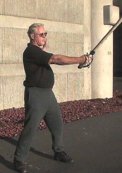
Figure 27a
|

Figure 27b
|
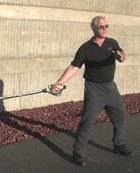
Figure 27c
|
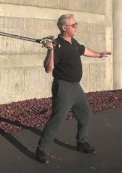
Figure 27d
|
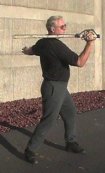
Figure 27e
|
|
Figures 27a through 27e demonstrate the modified side return, which can be called the "half teardrop". Figure 27f provides a front view of the motion just after Figure 27d.
As the sword starts moving forward:
1. The sword arm must be quickly bent, and the elbow must lead the movement forward. The sword hand should trail slightly behind the elbow.
2. The sword hand must be curled up towards the top of the sword shoulder, passing without pausing through the point of the shoulder where the sword would be at rest in an on-guard position, but not stopping.
|
|

Figure 27f
|
|
3. As the sword moves forward over the shoulder, it must be horizontal, and the tip must be pointing straight back. Until it starts to swing around, the entire sword should follow along the same horizontal path. It is important to move the sword precisely on this path. Deviation will lead to loss of power, and a restriction of the possible targets.
If the sword tip is not at the same level as the sword hand, so that the entire sword does not follow the horizontal line, it will be necessary to expend extra energy and time to pull it over your shoulder. Since you are then pulling it over and down, your choice of targets is restricted to those close to the vertical.
If you allow the sword tip to move in back of your head to your shield side, it will be necessary to expend extra energy and time to pull it around your head. Since you are pulling it around sideways, your choice of targets is restricted to those close to the horizontal.
4. As the sword passes over the shoulder, the shield shoulder must be moved quickly back. This allows the sword to remain in its horizontal path for a few inches longer.
5. The sword hand should be able to move about ten to twelve inches in front of the shoulder before the sword starts to swing around.
6. As the sword starts to swing around, pull the sword hand slightly towards the shield side, then allow it to move back towards the sword side as the swing completes.
It is possible to swing blows to the offside with this technique. Just as the hand starts moving forward along the horizontal line (at the end of step 2), start pushing forward with your thumb. As the sword hand passes over the shoulder (step 4), turn your head slightly to the shield side. The sword hand passes in front of your head.
- Whip around the corner (from overhead return)
From the overhead return, it is important that the next blow not be started by moving your sword hand immediately forward. If you do this, the sword will simply change ends, without much power at all. Your sword hand should move slightly back as your hips start to move forward, then forward towards the target. The sword will start to follow the hand back, then "whip" around the corner to move forward. This adds a lot of power to the blow.
Note in Figures 28a through 28c, the hand moves slightly back as the hip starts to twist forward.
|
|

Figure 28a
|
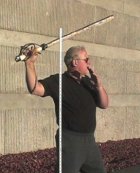
Figure 28b
|
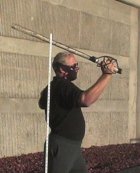
Figure 28c
|
|
In addition to technical issues, there can be problems with attitude or with your approach to the game. It may not be politically correct to say so, but relying on speed, strength, agility, quickness, or aggression is a losing game. Those are not, and will not be your strong points.
The way to win against more powerful and faster fighters is to be more perceptive and better technician than they are. Learn to "read" the fight and your opponents so well that you are moving to block or strike while they are still making up their mind to execute the technique to which they are already committed. Be able to perform your techniques flawlessly so that you can take advantage of the openings, and hit them hard enough to "kill".
If you believe that this is not the case, and that you can match up to anybody with your speed and power, or if you are not interested in technique, and want to be a "stick jock" or "just one of the boys", then I suggest that you are wasting your time with this manual.
The keys to learning these things are technique practice and slow work. Train smart, and fight smart. Look at any technique that somebody recommends to you. Apply some common sense, in light of what you have learned here. Does it allow you to swing with power and speed? Does it force you to match reactions with somebody stronger and faster? Will it only work on unskilled opponents? Does it inhibit the next technique?
In conclusion, remember to learn slow and polish fast. As I have said many times before, slow work is extremely important in the learning process. Moving fast feels better, but you can't tell if you are performing the technique correctly, or simply glossing over your mistakes. You must train slowly enough that you have time to notice what you are doing. It's necessary to eventually make the transition to fast speed, but you don't do this until you can do the technique correctly.
|